Swamp Skink
Swamp SkinkLissolepis coventryi | |
|---|---|
| Kingdom: | Animalia |
| Phylum: | Chordata |
| Class: | Reptilia |
| Order: | Squamata |
| Family: | Scincidae |
| Status | |
| World: | Endangered (IUCN Red List 2025) |
| Australia: | Endangered (EPBC Act 1999) |
| Victoria: | Endangered (FFG Threatened List 2025) |
| Profiles | |
| Australia: | Atlas of Living Australia |
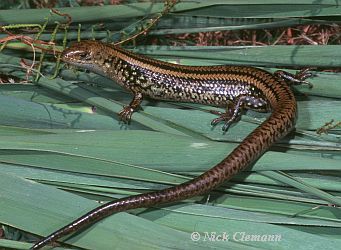
The Swamp Skink Lissolepis coventryi (formerly Egernia coventryi) is an attractive medium sized skink found mainly in the coastal region of south-eastern Australia, primarily south of the Great Dividing Range and mainly in Victoria with small areas in southern New South Wales and south-eastern South Australia.
A review of the genus Egernia was completed in 2008. This involved the molecular phylogenetic analysis of genus Egernia which resulted in re-instatement of the genus Lissolepis as a valid genus (Gardner 2008) with two species.
- Lissolepis coventryi - Swamp Skink or Eastern Mourning Skink (south-eastern Australia, primarily Victoria)
- Lissolepis luctuosa - Western Mourning Skink (Western Australia).
Other species of skinks that were previously in the genus Egernia and on Victoria’s threatened species list (FFG Threatened List 2025).
- Liopholis guthega - Guthega Skink (Critically endangered)
- Liopholis montana - Mountain Skink (Endangered)
- Liopholis multiscutata - Heath Skink (Critically endangered)
Identification
The Swamp Skink grows to a maximum of 250mm in length, the dorsal colour varies between shades of greenish-brown, olive-brown or yellow-brown above. Many or all of the dorsal scales have a black anterior margin and some with black lateral edges which combine to form a conspicuous black stripe along each side of the back. Another black stripe is present from above the ear to the base of the tail, widening on the body to become a broad black upper lateral zone enclosing some paler scales. The head and limbs are usually flecked and streaked with blackish markings. The limbs often contain scattered pale spots, the throat and lower flanks often flushed with olive-green (Cogger 2000).
Distribution in Victoria
The Swamp Skink is mainly found within the southern half of Victoria with the population at the Grampians being the most northern.
In south-west Victoria, key areas are the Grampians (Greater Grampians bioregion), forests to the west of Portland (Glenelg Plain bioregion), Discovery Bay Coastal Park (Discovery Bay bioregion), Lake Pertobe at Warrnambool and the Long Swamp / Glenelg River area. In the Otway Ranges (Otway Plain & Otway Ranges bioregion) recordes exist east of Gellibrand. There are records in the Enfield State Forest, south of Ballarat (Central Victorian Uplands bioregion) (Clemann & Beardsell 1999).
In south Gippsland and the Mornington Peninsula records are within the Gippsland Plain bioregion. Important areas are the Lakes National Park, Bunurong Coastal Park in the Cape Patterson / Wonthaggi area and on the Mornington Peninsula in the Tootgarook and Hastings areas. Wilsons Promontory National Park is also a key area.
In East Gippsland, the Swamp Skink is found on the East Gippsland Lowlands predominately in the Cape Conran Coastal Park / Bemm River and Marlo areas, Wingan State Forest and Drummer State Forest.
To the east of Melbourne the Swamp Skink is found within the Highlands Southern Fall bioregion in the Bunyip State Park and from Mt Dandenong to Hoddles Creek and Yarra Ranges National Park.
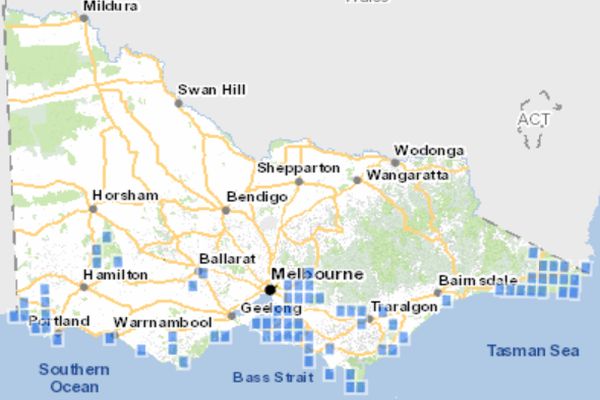
Important Local Government Areas for Swamp Skink
(number of records to April 2025 (Source: ALA 2025)
- Mornington Peninsula Shire 82
- East Gippsland Shire 23
- South Gippsland Shire 23
- Baw Baw Shire 19
- Cardinia Shire 17
- Bass Coast Shire 15
- Yarra Ranges Shire 13
- Casey City 10
- Northern Grampians Shire 9
- Glenelg Shire 8
- Moyne Shire 7
- Wellington Shire 5
- Warrnambool City 2
- Nillumbik City 1
- Golden Plains Shire 1
- Greater Geelong 1
- Knox City 1
- Kingston City 1
- Southern Grampians Shire 1
Previous unverified records exist in the following LGA's
- Surf Coast Shire
- Ballarat City
- Latrobe City
- Frankston City
- Colac Otway Shire
- Maroondah City
Habitat and ecology
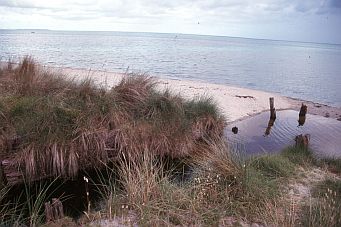 |
| Example of coastal habitat utilised by Swamp Skinks |
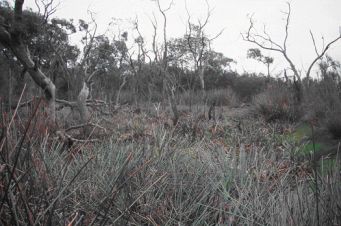 |
| Reinstated freshwater wetlands with abundant emergent vegetation provide habitat for Swamp Skinks |
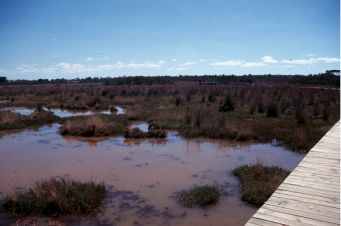 |
| Swamp Skinks may inhabit saltmarsh areas such as this protected wetland on the Mornington Peninsula. |
The Swamp Skink is often restricted to densely vegetated swamps and associated watercourses, and adjacent wet heaths (Melaleuca or Leptospermum thickets), sedgelands and saltmarshes (Clemann 2000, SAC 2000, Manning 2002). It can occur in association with freshwater and saltmarsh environments.
The Swamp Skink is a diurnal heliotherm that basks upon fallen timber, driftwood, sedges, and tussocks and is generally active between early-September to early-May. It is a secretive species that quickly retreats into shelter when disturbed, usually dense vegetation or burrows of its own construction, although it uses the burrows of freshwater crayfish, as well as rocks, logs, tussocks and sedges (Clemann et al 2004). The Swamp Skink is aggressively territorial and will chase other Swamp Skinks away from its territory (Clemann 2001a). It has a home range of about 10 metres from its burrow, and juveniles disperse up to 200 metres (Robertson 1980).
Mating occurs just prior to ovulation in October. Being viviparous (produces live young), the Swamp Skink normally has between one and six young (mostly three) in late January or early February (Clemann et al 2004).
Threats
In its final recommendation the Scientific Advisory Committee (SAC 2000) has determined that the Swamp Skink is:
- in a demonstrable state of decline which is likely to result in extinction
- significantly prone to future threats which are likely to result in extinction
Within Victoria, the Swamp Skink is known from only 72 sites. At five or six of these sites it is now presumed extinct; at 38 sites the area of suitable habitat is now so small that these populations are not likely to be viable in long term.; and at a further 22 sites its current status is uncertain. It is only considered secure at 12 sites and only at four sites outside East Gippsland, Discovery Bay Coastal Park being one of the secure sites in the South West (SAC 2000).
A significant threat is the lack of on-going monitoring of know populations.
Major causes of habitat loss
- Fragmentation of habitat through clearing, road and drain construction.
- Drainage of wetlands – resulting in changed hydrological conditions in terms of quality and quantity.
- Loss of vegetation due to heavy grazing pressure.
- Predation by feral predators such as Cats and Foxes.
- Weeds.
Known natural predators of the Swamp Skink include Ibis, various raptors and snakes such as the Lowland Copperhead, Easter Tiger Snake, Red-bellied Black Snake and White-lipped Snake (Clemann 2000).
Conservation of Swamp Skink in Victoria
The conservation status of Swamp Skink was re-assessed from Vulnerable in 2013 (DSE 2013) to Endangered in 2020 as part of the Conservation Status Assessment Project – Victoria (DELWP 2020).
Swamp Skink (Eastern Morning Skink) was Listed as Endangered under the EPBC Act 1999 on 23 March 2023.
Suggested Management
The major conservation objective for Swamp Skink is to ensure that the species survives and flourishes and maintains it potential for evolutionary development in the wild. This may be achieved by;
- Protecting existing habitat at known colonies of Swamp Skink
- Rehabilitate and restore degraded habitat.
- Reintroduce Swamp Skinks back to restored habitat which is adequately managed.
- Research to improve understanding of ecological requirements and surveys to monitor population trends.
Site management and habitat protection guidelines
- Retention of wetlands and where possible reinstatement of wetlands.
- Protect and restore areas of Woolly Tea-tree Leptospermum lanigerum.
- Control of Foxes and feral cats.
- Fencing off areas of known habitat from grazing.
Liaison & community engagement
- Ensure consultation with land managers and landholders regarding protection and site management of Swamp Skink habitat.
Research
- Survey suitable areas of habitat to determine the distribution and population status.
- Investigate techniques to restore degraded habitat and monitor outcomes.
Curent Management
A document which aims to provide guidelines for the protection and management of the habitat of the Swamp Skink on the Mornington Peninsula was written by Peter Robertson and Nick Clemann 2015.
Guidelines for management activities in Swamp Skink habitat on the Mornington Peninsula.pdf
References
AFD (2025) Australian Faunal Directory, Lissolepis coventryi - Eastern Mourning Skink, Department of Environment, Canberra. Accessed April 2025.
ALA (2025) Atlas of Living Australia, ala.org.au
Clemann, N. and Beardsell, C. (1999). A new inland record of the Swamp Skink Egernia coventryi Storr, 1978. The Victorian Naturalist 116 (4): 127-128.
Clemann N. (2000) Distribution, habitat utilisation and management of the threatened Swamp Skink Egernia coventryi at the Liverpool Road Retarding Basin, Boronia. Unpublished report to Melbourne Water.
Clemann N. (2001a) The Swamp Skink Egernia coventryi: A review of the biology and status, Monitor: Journal of the Victorian Herpetological Society, 11 (1), 13-15.
Clemann N., Chapple D.G., Wainer J. (2004) Sexual Dimorphism, Diet and Reproduction in the Swamp Skink Egernia coventryi, Journal of Herpetology, Vol. 38, No.3, 461-467.
Cogger H. (2000) Reptiles and Amphibians of Australia, Reed Books, Sydney.
Cogger H.G., Cameron E.E., Sadlier R.A., Eggler P. (1993) The Action Plan for Australian Reptiles, Published by the Endangered Species Unit, Australian Nature Conservation Agency
Project 124 (December 1993).
DELWP (2020) Provisional re-assessments of taxa as part of the Conservation Status Assessment Project – Victoria 2020, Department of Environment Land Water and Planning, Victoria. Conservation Status Assessment Project – Victoria
DSE (2013) Advisory List of Threatened Vertebrate Fauna in Victoria – 2013. Department of Sustainability & Environment, Victoria, East Melbourne, Victoria.
FFG Threatened List (2025) Flora and Fauna Guarantee Act 1988 - Threatened List - March 2025, Department of Energy, Environment and Climate Action (DEECA), Victoria.
Gardner (2008) Gardner, M.G., Hugall, A.F., Donnellan, S.C., Hutchinson, M.N. & Foster, R. 2008. Molecular systematics of social skinks: phylogeny and taxonomy of the Egernia group (Reptilia: Scincidae). Journal of the Linnean Society of London, Zoology 154: 781-794
IUCN (2025) Gillespie, G., Clemann, N., Robertson, P., Melville, J., Michael, D., Hutchinson, M. & Chapple, D.G. 2018. Lissolepis coventryi. The IUCN Red List of Threatened Species 2018: https://dx.doi.org/10.2305/IUCN.UK.2018-1.RLTS.T109480101A109480110.en. Accessed on 28 April 2025.
Manning B. (2002) Notes on the captive breeding of the Swamp Skink (Egernia coventryi), Heptofauna 32 (1) 2000, 35-38.
Robertson P. (1980) Alcoa Portland Aluminium Smelter Environmental Studies Report No.1 Mourning Skink Survey. Report by Kinhill Planners Pty Ltd, for Department of Natural Resources & Environment, Victoria.
Robertson P. (1988) Nomination for the listing on Schedule 2 of the Flora & Fauna Guarantee Act, 1988. Unpublished report by Wildlife Profiles Pty Ltd, for Department of Natural Resources & Environment.
SAC (2000) Final Recommendation on a nomination fro listing: Swamp Skink Egernia coventryi (Nomination No. 468). Scientific Advisory Committee, Flora & Fauna Guarantee. Department of Sustainability & Environment, Victoria, East Melbourne.
VBA (2025) Victorian Biodiversity Atlas, Department of Energy, Environment and Climate Action, Victoria (DEECA).

